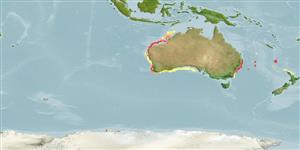Teleostei (teleosts) >
Anguilliformes (Eels and morays) >
Muraenidae (Moray eels) > Muraeninae
Etymology: Gymnothorax: Greek, gymnos = naked + Greek, thorax, -akos = breast (Ref. 45335); cephalospilus: From the Greek kephale meaning head and spilos meaning spot. Noun in apposition.
More on authors: Böhlke & McCosker.
Environment: milieu / climate zone / depth range / distribution range
Ecology
Marine; demersal; depth range 125 - 134 m (Ref. 41234). Subtropical
Indo-West Pacific: eastern and western Australia.
Size / Weight / Age
Maturity: Lm ? range ? - ? cm
Max length : 20.2 cm TL male/unsexed; (Ref. 41234)
Short description
Identification keys | Morphology | Morphometrics
Vertebrae: 142 - 146. A small, slender, dark brown moray with contrasting eye-sized white spots on head; spots fewer toward anus, very few or lacking on tail; anus at midbody, preanal length 2.0 in TL; depth at gill opening 18-22 in TL; head 8.2-9.3 in TL; teeth stout, no long canines; MVF 6-64-145.
Life cycle and mating behavior
Maturity | Reproduction | Spawning | Eggs | Fecundity | Larvae
Böhlke, E.B. and J.E. McCosker, 2001. The moray eels of Australia and New Zealand, with description of two new species (Anguilliformes: Muraenidae). Rec. Aust. Mus. 53(1):71-102. (Ref. 41234)
IUCN Red List Status (Ref. 130435: Version 2024-1)
Threat to humans
Harmless
Human uses
Fisheries: minor commercial
Tools
Special reports
Download XML
Internet sources
Estimates based on models
Preferred temperature (Ref.
123201): 17.9 - 22.2, mean 21.1 °C (based on 4 cells).
Phylogenetic diversity index (Ref.
82804): PD
50 = 0.5000 [Uniqueness, from 0.5 = low to 2.0 = high].
Bayesian length-weight: a=0.00048 (0.00025 - 0.00091), b=3.28 (3.12 - 3.44), in cm total length, based on LWR estimates for this Genus-body shape (Ref.
93245).
Trophic level (Ref.
69278): 3.7 ±0.6 se; based on size and trophs of closest relatives
Resilience (Ref.
120179): High, minimum population doubling time less than 15 months (Preliminary K or Fecundity.).
Fishing Vulnerability (Ref.
59153): Low vulnerability (10 of 100).
